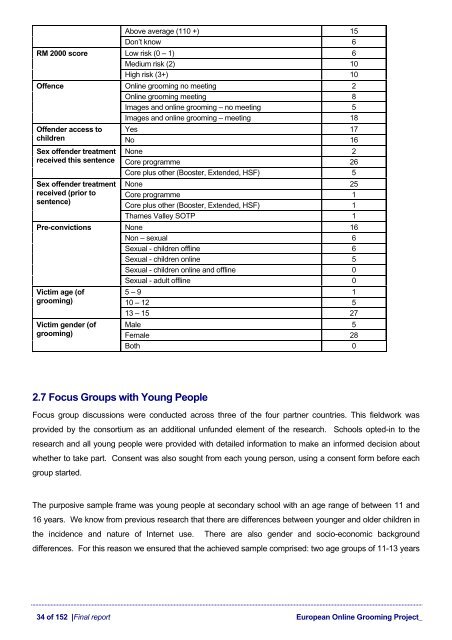Final Report - European Online Grooming Project
Final Report - European Online Grooming Project
Final Report - European Online Grooming Project
Create successful ePaper yourself
Turn your PDF publications into a flip-book with our unique Google optimized e-Paper software.
Above average (110 +) 15<br />
Don’t know 6<br />
RM 2000 score Low risk (0 – 1) 6<br />
Medium risk (2) 10<br />
High risk (3+) 10<br />
Offence<br />
<strong>Online</strong> grooming no meeting 2<br />
<strong>Online</strong> grooming meeting 8<br />
Images and online grooming – no meeting 5<br />
Images and online grooming – meeting 18<br />
Offender access to Yes 17<br />
children No 16<br />
Sex offender treatment None 2<br />
received this sentence Core programme 26<br />
Core plus other (Booster, Extended, HSF) 5<br />
Sex offender treatment None 25<br />
received (prior to<br />
sentence)<br />
Core programme<br />
Core plus other (Booster, Extended, HSF)<br />
1<br />
1<br />
Thames Valley SOTP 1<br />
Pre-convictions None 16<br />
Non – sexual 6<br />
Sexual - children offline 6<br />
Sexual - children online 5<br />
Sexual - children online and offline 0<br />
Sexual - adult offline 0<br />
Victim age (of<br />
5 – 9 1<br />
grooming)<br />
10 – 12 5<br />
13 – 15 27<br />
Victim gender (of Male 5<br />
grooming)<br />
Female 28<br />
Both 0<br />
2.7 Focus Groups with Young People<br />
Focus group discussions were conducted across three of the four partner countries. This fieldwork was<br />
provided by the consortium as an additional unfunded element of the research. Schools opted-in to the<br />
research and all young people were provided with detailed information to make an informed decision about<br />
whether to take part. Consent was also sought from each young person, using a consent form before each<br />
group started.<br />
The purposive sample frame was young people at secondary school with an age range of between 11 and<br />
16 years. We know from previous research that there are differences between younger and older children in<br />
the incidence and nature of Internet use. There are also gender and socio-economic background<br />
differences. For this reason we ensured that the achieved sample comprised: two age groups of 11-13 years<br />
34 of 152 |<strong>Final</strong> report <strong>European</strong> <strong>Online</strong> <strong>Grooming</strong> <strong>Project</strong>_


